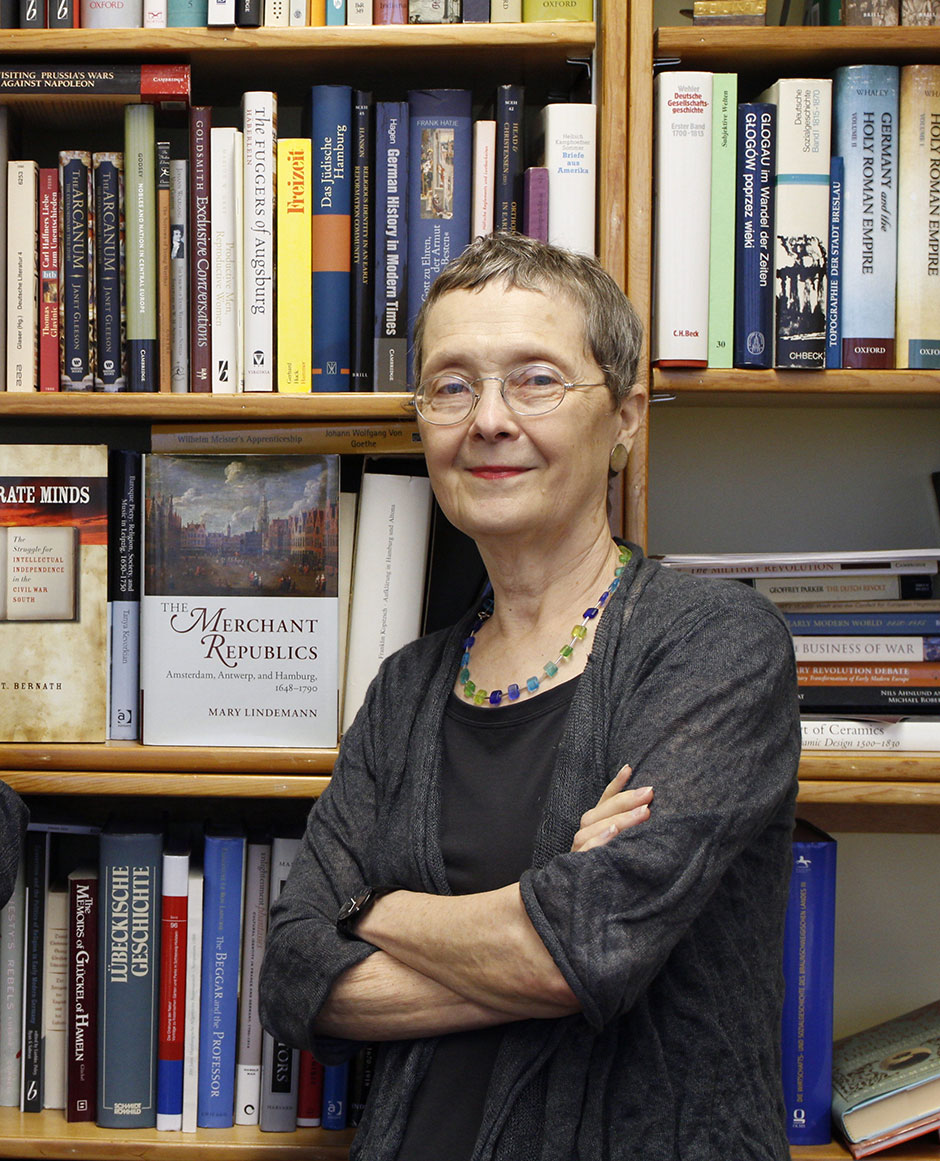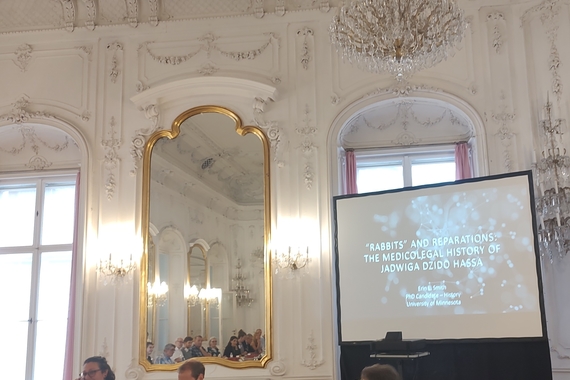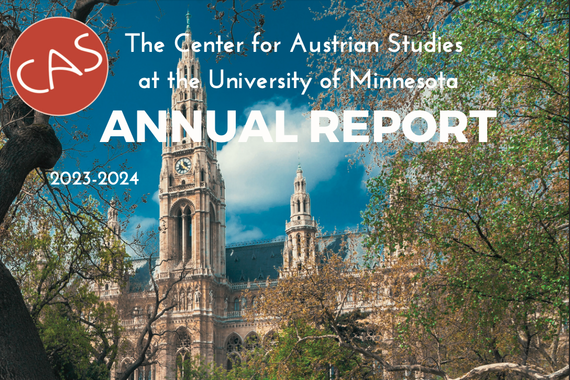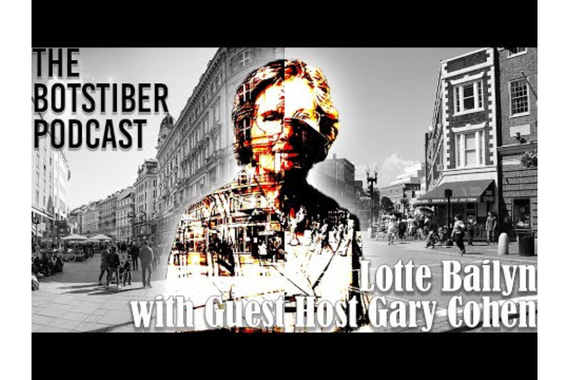Interview with Professor Mary Lindemann

James Gresock: How would you say your background has influenced the way you practice history, both in terms of what you study and the ways in which you look at it?
Mary Lindemann: I think I’m quite eclectic in my approach to history. In fact, I’ve never done the same type of research twice. I’ve done several different things topically or thematically, though I’ve often stayed in the same general area of Northern Germany. My first book, Patriots and Paupers: Hamburg, 1712–1830 (Oxford University Press, 1990), was on poor relief in Hamburg. In it I had a section on medical care and medical poor relief and, as a result, I became interested in the history of medicine. Following the publication of my second book, Health and Healing in Eighteenth-Century Germany (Johns Hopkins University Press, 1996), I signed a contract with Cambridge to do a survey called Medicine and Society in Early Modern Europe (1999). After that, I became interested in another topic that first caught my attention while researching years before in the Hamburg archives. There I discovered considerable material on sensational crimes and, at first, I thought I might write a book about these crimes, and similar ones in Amsterdam, and Antwerp. However, I soon noticed that much of my material was about political corruption. I therefore became very interested in how the idea of corruption and its reality formed major themes in mercantile life. Building on this perspective, I decided to write about how merchant republics actually worked. The result was The Merchant Republics: Amsterdam, Antwerp, and Hamburg, 1648–1790 (Cambridge University Press, 2015).
While I was working on The Merchant Republics, I ran across a very thick file that at first I thought I might incorporate into a book on sensational crime. But it soon took on a life of its own and became Liaisons dangereuses: Sex, Law, and Diplomacy in the Age of Frederick the Great (Johns Hopkins University Press, 2006). So, after having written three books on Hamburg or where Hamburg played a major role, I decided I wanted to move away from Hamburg and, for that matter, back in time from the late eighteenth to the seventeenth century.
At the time, about 2015, there were many historians working on the Thirty Years’ War, but it seemed to me from what I had read, that not many had looked at the aftermath of the War except to discuss the Peace of Westphalia as a new international and diplomatic system. I wasn’t interested in that aspect, but I thought maybe I should look at two places in Northern Germany where there had been significant destruction during the war and how those places were rebuilt. I decided to compare Mecklenburg and Brandenburg. Eventually that comparison proved impossible because of some archival deficiencies in Mecklenburg. I then decided to focus exclusively on Brandenburg. As I started to trawl through the documentary material, I began to perceive the importance of the environment. It’s not that I said, “I’m an environmental historian, so I want to work on the environment after the Thirty Years’ War.” I started with a much different set of questions and ended up being convinced by the documents that the history of the built and natural environment was an especially important part of a larger story.
JG: You covered the whole breadth of your career, publications, and story of how you came to your research through archival work into topical themes. So we’ve come to the topic of your keynote lecture The Ecological and Environmental Consequences of the Thirty Years’ War, and I was wondering if you would be able to condense the arguments of your presentation into the two most important themes.
ML: First, there are several different ways in which rebuilding actually reshaped the entire landscape. The destruction caused by the war itself was extreme. However, another critical factor is often ignored: sheer neglect. I was interested in the multiplicity of ways in which the landscape had been formed, or de-formed by the war, and then, the multiplicity of ways the landscape was transformed by rebuilding. Second, the process of rebuilding took place on all levels and involved multiple agents; the elector, estate owners, managers, and peasants. All engaged in the process of rebuilding and significantly transformed the landscape and the built environment. At the same time, they were rebuilding and reshaping Brandenburg in ways that differ from the kind of things normally associated with an older story of “the rise of Prussia,” such as the creation of standing armies, the suppression of the estates, the rise of a “second serfdom,” and the centralization of the administration. So I’m arguing that the process of rebuilding also created a different political culture.
JG: So you take this environmental destruction as a jumping off point to look at the various ways that the recovery efforts affect manifold different processes: the social, political, cultural, economic, and explicitly agricultural, too.
ML: Yes, exactly. And if you think about it for one second, it’s really quite an easy formulation. For example, in these areas that were especially badly devastated, there’s supposed to be a population loss of 75-90%. Many people migrated, of course, and had not died, nonetheless the indubitable population decline meant that not only was a village depopulated to a greater or lesser extent, but also many of the important social, economic, and political actors in that village were gone; some returned, some did not. Villages determined agricultural life and how fields were distributed, and that had to be redone. The process was inherently political as well as social and economic.
JG: The way I see this project unfolding is that there are almost endless ways we can look at it. We can look at different agents, we can zoom in on economic, on social, on political aspects. I was wondering if you could speak about the book without giving too much away and mention what angles you might not engage with, but that could be fertile ground for other academic research.
ML: I see the book shaping up as having a joint chronological and thematic organization. I begin by analyzing the destruction or neglect and then turn to considering the immediate rebuilding. Then I might break these themes down into the ways in which particular things were rebuilt or newly constructed. For example, what was done with the rivers and fluvial landscapes, what was done with fields, what was done with forests, what impact on the landscape did the establishment of new “industries” have. I also intend to look at migrants to “empty lands” and see how these people’s lives were transformed from being villagers to being laborers.
One thing people might miss is an extended discussion of serfdom. They will want to know: where are the serfs and what role did serfdom play? Much work done over at least the last 20 years has argued that serfdom is a bit of a red herring or, rather, a far more complicated subject than the phrase “the rise of a second serfdom” catches. Yes, there’s Leibeigenschaft in some areas of Brandenburg but not everywhere. Moreover, serfdom is not necessarily exploitative because the serfs often got advantageous deals because of the dearth of laborers
In addition, I want to describe and analyze the different perceptions of how people move through the landscape and how this has changed as they changed the landscape. There’s an enormous amount of hydraulic engineering that goes on in very simple, day-to-day ways. It was not very difficult to divert a stream thereby flooding a field or meadow, and thus robbing one village of land while increasing the land available to others
JG: You are an outgoing president of the German Studies Association (GSA) and I was wondering how, as president of the GSA, you have dealt with the challenging climate in liberal arts? What initiatives have you taken as president to confront this challenge?
ML: It’s a huge structural issue and the GSA can only do so much. We are very, very active in the sense that we give academics a home, we give them a place to come to present their material, to develop connections, to network, and that’s all very useful. But we also, over the last decade, have spent a fair amount of time protesting the closing down of German Languages and Literature programs. The GSA is German studies organization; it’s not just for historians and history. Some universities have recently decided that German Language and Literature departments should become language teaching departments. While those universities can’t get rid of tenured-track people, they are able to let go untenured faculty. Then they allow departments to die by attrition or force their members to teach only elementary German classes. The argument behind such cuts is that German courses do not draw large enrollments. But actually the real problem is that many of these universities have done away with core requirements as well as distribution requirements, so they thereby are structurally destroying the languages. We also represent the German academic community vis-à-vis the German government and vis-à-vis the German embassy. We solicit funds for certain programs like the Berlin Program which supports advanced doctoral students, PhDs, and post-docs. There’s a whole range of things we do for people who are early career scholars, whether they are people who are just finishing up their PhDs or have finished up their PhDs. We also, of course, argue for the retention of German studies programs. We have worked very closely with the teachers of German, whether in elementary school or at the university level. We also spend a fair amount of time working with foreign academics who want to come to the United States for scholarly purposes (to attend conferences or give lectures) and who have been refused visas. We also deal with archives, archive access, archive collections, and archival preservation. The fate of the Captured German Documents brought to Alexandria, Virginia, after World War II is a prime example. Twenty or thirty years ago, thousands of reels of microfilms were returned to Germany. The problem now, just to give you some example of the kinds of things we deal with, is that those microfilms are deteriorating. Not only are they deteriorating, but the paper, the actual documents on which they are written, is almost illegible. So there has to be some kind of massive program put into action to digitize this collection; it will be expensive and time-consuming.
JG: You’re the outgoing president of the GSA, but you’re the incoming president of the AHA (American Historical Association) beginning in 2020. Can you compare these two organizations and how your duties will differ as president of the AHA from the GSA?
ML: Right, I will become AHA president in 2020, but I’m president-elect in 2019. The GSA is a different kind of organization than the AHA. The GSA has only one full-time staff member and that’s the executive director. The AHA also has an Executive Director and a Deputy Director as well as 19 or 20 full-time staff. So it’s a much bigger umbrella organization that includes historians from K-12 to senior professors in the field, as well as public historians of all kinds. So it has far more diverse audiences in the sense of career interests and it must represent all those people. It also does an enormous amount of work in lobbying, particularly involving Congress and the Freedom of Information Act. It takes on cases of scholars who have been poorly treated by their university. It has all sorts of programs and institutes for primary school teachers. The president’s role is to be the public and scholarly face of the AHA; s/he does not set the “agenda” of the organization.
In terms of my platform, one of the things people often insist is that the AHA should be comprehensive and everybody should feel comfortable there. That almost goes without saying. I think most people accept that the AHA should be very inclusive both in personal terms and in what people do, the kind of history they do, and at what level they work. That’s set in stone at the AHA. It’s not going to change and it’s a good policy.
Most of all, I believe, we need to defend the humanities very vigorously without being defensive about it. We do need to emphasize the many job potentials for those with humanities degrees. There are lots of people who will employ you. But I don’t think we need to say only that. We, sometimes, in the concern to get people jobs and to encourage people to study the humanities, are too functionalist and we don’t stand on our intellectual ground. We sometimes forget that there is an intellectual good to education. Yes, we want all our PhDs to get jobs. On the other hand, even if they don’t get jobs, their lives are not necessarily ruined. I feel terrible when people who have done really excellent dissertations cannot get a job. It’s really unfair, it’s horrible, all that’s true. On the other hand, their brain has not been polluted. It’s still going to function and they can do many other things with their education.
JG: Exactly—it’s sort of a commentary on the value of a PhD itself.
ML: The other thing we should do—and this has nothing to do with the AHA, but rather because I am chair of a department—is to be rather ruthless in defending departments against cuts. And you can do useful things; you just have to be determined and proactive about it. For example, my department—and admittedly this won’t work for every department—has no adjuncts. Not one. We have exactly one lecturer position and that is a special case. I refuse to hire lecturers or adjuncts. This strategy doesn’t always work, but I think sometimes we give in too easily to these demands when we can actually dig in our heels and say no. We also need to tell people that just because faculty teach four or five courses a semester does not make them better teachers. It doesn’t work that way. Anyway, that’s my philosophy.
JG: A lot of what you were talking about was the value of a PhD, being proactive in valuing PhDs, and I wanted to connect that work to GSA and the interdisciplinary nature of that organization. Do you think that there should be more interdisciplinarity in historical PhDs?
ML: Not necessarily. I think the real strength of history is that it’s ecumenical. Historians do many different things. If they want to work interdisciplinarily, that’s great. But it’s not simple. There are some disciplines that are very close to history such as anthropology. But it is wise to remember that working across disciplines requires you to master the methodology and literature of not just one field, but two or more fields, and that’s not easy. There’s a lot of pressure put on graduate students and put on us, teaching graduate students, to push students through to graduate quickly. But you can’t expect them to do six different things and still be done in five years. As for environmental history, I’ve read a lot of material about soil and manure and trees. So, right now, I am, I guess, working across disciplines, but I don’t think you have to do that to be a good historian. I do some collaborative work and many scholars find it productive and fulfilling . But for some people it doesn’t work at all. There is, in the end, no single right way to do history.


